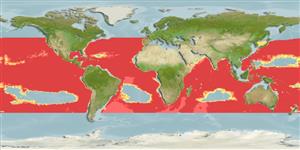Actinopterygii (ray-finned fishes) >
Cetomimiformes (Whalefishes) >
Cetomimidae (Flabby whalefishes)
Etymology: Ditropichthys: Greek, di = two + Greek, tropos = turning + Greek, ichthys = fish (Ref. 45335).
Environment / Climate / Range
Ecology
Marine; bathypelagic; depth range 650 - 3400 m (Ref. 50610), usually 1000 - 2000 m (Ref. 33390). Deep-water, preferred ?; 45°N - 45°S
Atlantic Ocean: between 41°N-43°S, in the eastern Atlantic it is found south of Canary Islands to east of Ascension Island; in the western Atlantic it is known from the USA to Argentina. Indian Ocean: between 8°N and 19°S. Pacific Ocean: 45°N and 34°S. Distributional gaps in the central south Atlantic, south Indian and various parts of the Pacific are presumably due to inadequate sampling. This species appears to be circumglobal in distribution.
Size / Weight / Age
Maturity: Lm ? range ? - ? cm
Max length : 12.8 cm SL male/unsexed; (Ref. 9791)
Juveniles (less than 3.5 cm) were captured in shallower depth range (650-877 m). Larger specimens appear to dwell deeper (Ref. 9791).
Life cycle and mating behavior
Maturity | Reproduction | Spawning | Eggs | Fecundity | Larvae
Paxton, J.R. and D.J. Blake, 1990. Cetomimidae. p. 607-608. In J.C. Quero, J.C. Hureau, C. Karrer, A. Post and L. Saldanha (eds.) Check-list of the fishes of the eastern tropical Atlantic (CLOFETA). JNICT, Lisbon; SEI, Paris; and UNESCO, Parisl. Vol. 2. (Ref. 6532)
IUCN Red List Status (Ref. 115185)
CITES (Ref. 94142)
Not Evaluated
Threat to humans
Harmless
Human uses
More information
Common namesSynonymsMetabolismPredatorsEcotoxicologyReproductionMaturitySpawningFecundityEggsEgg development
Age/Size
Growth
Length-weight
Length-length
Length-frequencies
Morphometrics
Morphology
Larvae
Larval dynamics
Recruitment
Abundance
ReferencesAquacultureAquaculture profileStrainsGeneticsAllele frequenciesHeritabilityDiseasesProcessingMass conversion
Tools
Special reports
Download XML
Internet sources
